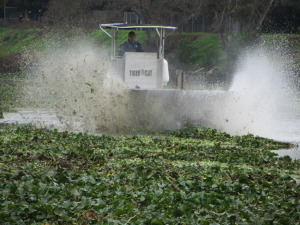The boat cut its engines so we could hear the eerie, disembodied sound of hundreds of geese calling from behind the cold, damp curtain of fog. Shortly thereafter, that curtain began to lift, and we were able to make out countless forms that soon resolved into a huge flock of snow and white-fronted geese massed on a field in the Webb Tract, one of the many subsided islands in the Sacramento-San Joaquin River Delta. When the flock suddenly lifted off, spooked by a passing harrier, the beating wings and raucous calls of a thousand birds rising and wheeling as one echoed right past my brain and into my gut.
When it comes to wetlands and bodies of water, we in the Bay Area tend to look to the Bay or the Pacific. The Delta is pancake flat, hot in summer, cold and gray in winter, and a little strange for those of us adapted to the world of hip cafes and green hills. It’s a place that’s hard to penetrate if you don’t have a boat and a sense of the incongruous. But for an immediate and primal experience of nature nearby, it’s hard to beat the Delta’s wintertime congregations of geese, swans, pintails, and sandhill cranes.
However, that riotously abundant bird life masks an ecosystem in crisis. Geese, swans, and cranes find nourishment in the sunken farm fields that lie behind the Delta’s network of weak and aging levees. But the fish in the rivers and sloughs tell another story, a story of the transformation of the Delta from a dynamic, complex, tidally shaped estuary into a constrained, threatened, static, and human-shaped wetland. All the court decisions, headlines, and diatribes about the tiny Delta smelt are really about that bigger decline, with the smelt standing in for a whole suite of species adapted to a bygone Delta.
This larger Delta story is the one we tell in this issue of Bay Nature, in part because it’s fascinating, and in part because it’s essential. With its fragile system of earthen levees and subsided islands threatened by sea level rise and earthquakes, the Delta is going to change, and sooner rather than later; the question is, what kind of change? This matters to us because the Delta is the heart of the watershed that includes and feeds into San Francisco Bay; what goes through the Delta arrives on our doorstep. And the Delta is at the heart of the state’s notorious water wars; as much as we’d like to think those are about farms in the Central Valley and swimming pools in Southern California, many Bay Area residents get their water supply straight from the Delta or from higher up in the watershed before it has a chance to get there. So we’re part of the Delta’s problems too. And this coming November, we’re being asked to weigh in on an $11.4 billion water bond that some call a solution to those problems and others claim will make them worse.
Our role at Bay Nature is not to tell you how to vote. But we invite you to look behind the rhetoric of “farmers vs. fish” and see for yourself what’s at stake in this unique, strange, complex, and fascinating landscape at the eastern edge of the Bay Area.

.jpg)



